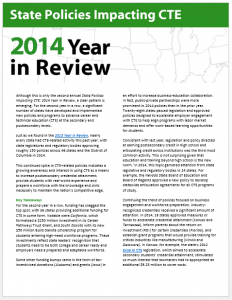 On Tuesday, Secretary of Education Arne Duncan testified before the House Labor, Health and Human Services and Education Appropriations Subcommittee regarding the Obama Administration’s FY 2015 budget request for education. As we shared previously, the Administration requested $1.117 billion for the Carl D. Perkins Career and Technical Education Act’s (Perkins) basic state grant program— a figure that would maintain the same level of funding as in FY 2014, but would keep the program below pre-sequestration levels. The request also proposed to use a portion of these funds for a competitive “innovation fund†similar to what the Administration has previously proposed in its 2012 Blueprint for Career Technical Education (CTE).
On Tuesday, Secretary of Education Arne Duncan testified before the House Labor, Health and Human Services and Education Appropriations Subcommittee regarding the Obama Administration’s FY 2015 budget request for education. As we shared previously, the Administration requested $1.117 billion for the Carl D. Perkins Career and Technical Education Act’s (Perkins) basic state grant program— a figure that would maintain the same level of funding as in FY 2014, but would keep the program below pre-sequestration levels. The request also proposed to use a portion of these funds for a competitive “innovation fund†similar to what the Administration has previously proposed in its 2012 Blueprint for Career Technical Education (CTE).
During the subcommittee hearing, members from both parties strongly questioned these aspects of the budget request, asked why additional funds were not requested for the Perkins Act and voiced strong opposition to the Administration’s other proposals for new competitively funded programs.
“The concern is that these proposals would be made at the expense of meeting our current obligations,†Rep. Lucille Roybal-Allard (D-CA) said. The ranking Democrat on the subcommittee, Rep. Rosa DeLauro (D-CT), echoed these sentiments and emphasized the importance of the overall federal investment in education. The full hearing and testimony transcripts can be found here.
Rep. Martha Roby (R-AL) questioned the Secretary further on these issues asking, “Why does the Administration continue to propose competitive grants that only benefit a few students rather than investing in proven programs like CTE that help to further the goal of career readiness for all students?â€
Secretary Duncan did point out that 89 percent of the funds from his department actually go to formula programs and that the Administration on the whole has invested heavily in CTE via alternative funding streams such as the Youth CareerConnect program.
However, there was genuine skepticism from many of the members present for how these proposals would negatively impact the ability of students to equitably access CTE programs throughout the country. As Rep. Roby pointed out, “We have yet to fulfill our commitment to fully fund existing formula-driven programs.â€
To that end, members of Congress on and off the subcommittee have been hard at work over the past several weeks to push for additional investments for the Perkins Act ahead of the Congressional FY 2015 appropriations process. Two Dear Colleague letters, one in the House and the other in the Senate, were supported on a bipartisan basis by 93 Representatives and 25 Senators respectively, calling for a restoration of the Perkins Act basic state grant program to pre-sequester levels.
NASDCTEc encourages its members and those in the CTE community to reach out to all of the lawmakers who supported these efforts and thank them for their strong support for the Perkins Act and CTE. Special recognition must go to Sens. Blumenthal (D-CT), Kaine (D-VA), Baldwin (D-WI) and also Reps. Thompson (R-PA) and Langevin (D-RI) who lead these efforts in both Chambers.
Don’t know how to get in touch with Congress? Find out here!
Perkins Amendment Introduced in the House
Earlier this week Reps. Joe Kennedy III (D-MA), Adam Kinzinger (R-IL), Rodney Davis (R-IL) and Jared Polis (D-CO) introduced the “Perkins Modernization Act of 2014,†which seeks to more closely align CTE programs with labor market needs. Specifically it would substitute all references to “high skill, high wage, or high demand occupations in current or emerging professions,” currently found in the Perkins Act and substitute them with “employment in current or emerging in-demand industry sectors or occupations.†A definition for an “in-demand industry sector or occupation†is also proposed, which would be informed to a greater extent by labor market information culled from various sources at the local, state and national levels.
As the House Committee on Education and the Workforce (HEW) along with the Senate Committee on Health, Education, Labor and Pensions (HELP) continue to work to reauthorize the Perkins Act, it is important to note that the above proposal is not a comprehensive reauthorization bill. Instead the Perkins Modernization Act introduces into the reauthorization discussion an issue important to these members of Congress. NASDCTEc appreciates Reps. Kennedy, Kinzinger, Davis, and Polis’ recognition that CTE programs are crucial components to the nation’s economic competitiveness and agrees that a greater availability and use of labor market information is needed to ensure that CTE programs prepare students for success in the workforce.
NASDCTEc looks forward to working constructively with Congress to thoughtfully reauthorize the Perkins Act and to ensure that programs are empowering students with the necessary skills and knowledge demanded by today’s employers and affording graduates the opportunity to secure family-sustaining wages.
House Education and the Workforce Committee Moves on ESRA
The House Education and the Workforce Committee (HEW) moved forward on the Strengthening Education through Research Act (H.R. 4366). This bill, introduced by Representatives Todd Rokita (R-IN) and Carolyn McCarthy (D-NY), reauthorizes the Education Sciences Reform Act (ESRA). Currently, ESRA supports educational research programs such as the National Center for Education Statistics (NCES), NAEP exams, and state longitudinal data systems. “Quality education research is critical to successful schools,†Rep. Rokita said upon the Committee’s approval of the bill by voice vote.
A particularly promising aspect of the bill would amend the authorization for state longitudinal data system grants to encourage the alignment of data across K-12, postsecondary and workforce programs. This would greatly support efforts to report on post-program employment outcomes for CTE graduates. Moreover, H.R. 4366 emphasizes the importance of using data effectively and lays out a more thoughtful approach to its use. The Workforce Data Quality Campaign, of which NASDCTEc is a national partner, supported this bill. The text of the bill, fact sheets, and other useful information can be found here.
Senators Introduce Bipartisan Apprenticeship Bill
On Wednesday Sens. Cory Booker (D-NJ) and Tim Scott (R-SC) introduced the Leveraging and Energizing America’s Apprenticeship Programs (LEAP) Act, a bill that incentivizes employers to increase the number of apprenticeships available to young people. Specifically the LEAP Act would grant companies a $1,500 tax credit for hiring new registered apprentices under the age of 25. A $1,000 tax credit would also be offered to employers hiring apprentices older than 25 years of age. The bill would also incent the expansion of existing apprenticeship programs
The Workforce Investment Act
Both Chambers of Congress have continued discussions on the Workforce Investment Act (WIA) this week. According to recent reports, the Chairman of the Senate HELP Committee, Tom Harkin (D-IA) and Chairman of the House HEW Committee, John Kline (R-MN), have publicly stated that they have “resolved nearly all differences†and hope to complete the legislation when Congress returns from recess in late April.
“The likelihood is that the staff will be able to hammer out what is left while we are gone,†Chairman Kline said. “Hopefully, by the time we come back, we’ll have it all put together,†Chairman Harkin was reported as saying.
There has also been speculation that the reauthorization of WIA could possibly be attached to Congress’ consideration of extending unemployment insurance benefits. NASDCTEc will monitor this process as it evolves and will continue to work with policymakers to ensure that a thoughtful reauthorization of the law emerges from these negotiations.
Steve Voytek, Government Relations AssociateÂ





